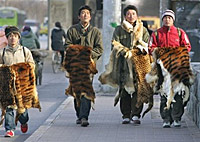




KATHMANDU—Chinese authorities in the Amdo Tibetan region of northwest China have ordered Tibetan broadcasters to add fur trimmings to their traditional clothing, in an apparent jab at an anti-fur movement inspired by Tibet’s exiled spiritual leader, the Dalai Lama.
Che Xizhen, head of the Qinghai provincial propaganda department, and Rinchen Gyal, head of the provincial Communist Party’s ideology-focused United Front Work Department, visited the Qinghai television station, where they announced that Tibetan-language broadcasters must wear fur-lined traditional Tibetan clothing, a source close to the station said.
This is a matter of politics and as such, you all will have to add fur trimmings. If you don't have furs, then you'll have to buy furs and we'll allocate you funding for that.
“The two of them came to the television station and gave orders, saying, ‘You’ve got to add fur linings to your clothes. This is compulsory or else.’"
"So the program presenters must get their ‘chupas’ trimmed with fur lining as soon as possible when appearing on television,” the Tibet-based source said, referring to traditional Tibetan tunics.
He said the broadcasters had opposed the order, saying they had no money to buy furs. But the officials said they would allocate a budget of 10,000 yuan (U.S. $1,250) for the furs.
“This is a matter of politics and as such, you all will have to add fur trimmings. If you don’t have furs, then you’ll have to buy furs and we’ll allocate you funding for that,” the officials told broadcasters, according to the anonymous Tibetan source.
“Just two or three days after that, after the compulsory orders were given by the two leaders, the television presenters started appearing with small fur linings,” he said.
The anti-fur campaign is thought to have begun in Rebkong county, Malho prefecture, in the remote northwestern province of Qinghai.
Residents began burning tiger, leopard, and sea otter skins publicly against the wishes of Chinese authorities in early February after the Dalai Lama called on Tibetans to protect endangered species in January.
Qinghai television station chief Bai Jubi confirmed the news to RFA’s Tibetan service but cited aesthetic reasons for the move.
“Yes, it is true that television staff were given money to buy clothing,” Bai said. “The main reason is the dress that our staff wears is old and isn’t bright and colorful.”
“We wanted to improve Tibetan traditional dress with the latest designs, but the Tibetan section of the Qinghai television station lacks funds. Therefore the United Front Work Department helped with money and supported us,” he said.
Bai said the funding was provided to improve the image of a government television station.
“We are the mouthpiece for the government. That is the reason why they support us with money for the clothing. Viewers watch our shows every day and comment about the show, including dress. They expressed dissatisfaction,” Bai said.
But a local Han Chinese source familiar with the situation said the move was an obvious undermining of the Dalai Lama.
“With regard to the current popular movement initiated by the people themselves for the protection of wildlife, the Chinese have come to recognize and understand that it is principally inspired by His Holiness the Dalai Lama, who asked for the support of the Tibetan people for the protection of wildlife and the natural environment of Tibet during the Kalachakra teachings at Amaravati in South India,” the man said.
“So they came to the conclusion that it is not right for people to follow and obey the instructions of His Holiness, that it isn’t advisable to allow people to carry out the wishes of His Holiness and the Tibetan Government [in Exile],” he added.
Overseas animal rights groups have slammed China’s booming fur trade, which includes the use of domestic cat fur in accessories and ornaments, saying that traditional cultures did not need to infringe on animal rights.
Rosa Close, a spokeswoman for the U.S.-based Anti-Fur Society said China, which now produces most of the fur exported to the world, had become notorious for the brutal treatment of fur-bearing animals, both exotic and domestic.
"Although the Dalai Lama specifically mentioned "endangered species" of fur-bearing animals, with no mention of farmed fur animals, we are still very happy with his pronouncement," Close said in a statement e-mailed to RFA's Tibetan service.
"This positive reaction from the brave, and long suffering, Tibetan people sends a strong message to the Chinese: that it is not acceptable to use fur," she said.
Baltimore-based International Anti-Fur Coalition member Roben Euler said that unwanted furs could be given to the group People for the Ethical Treatment of Animals (PETA), which donates them to the freezing and the homeless, or uses them for educational purposes.
“The actions of Chinese authorities in flooding American markets with furs and animal products are despicable,” Euler said. “All those who own cats and dogs should boycott Chinese products made of animal skins.”
China has recently stepped up propaganda efforts aimed at Qinghai’s Tibetans, launching a new channel broadcasting 17.5 hours of programs daily in the Amdo dialect, including news broadcasts, dubbed movies, and drama series.
More than half of the five million Tibetans in China speak Amdo. The station had previously broadcast in the mutually unintelligible Lhasa dialect. Amdo speakers can be found in Qinghai, Gansu, and Sichuan provinces.
Original reporting by the Amdo section of RFA’s Tibetan service. Director: Jigme Ngapo. Additional editing and translation by Karma Dorjee. Written and produced for the Web in English by Luisetta Mudie. Edited by Sarah Jackson-Han.